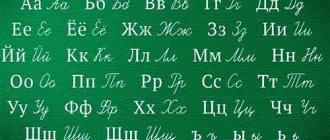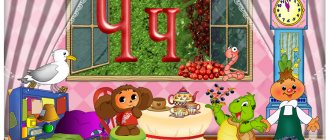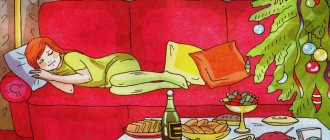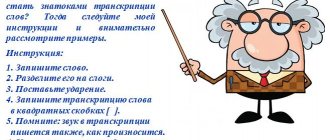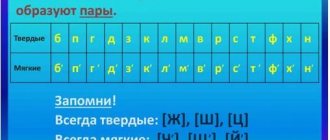В, в - The third letter of all Slavic and most other Cyrillic alphabets. In the Old and Church Slavonic alphabet it is called “vede” or “vedi”. In the Cyrillic alphabet it looks like and has the numerical value 2, in the Glagolitic alphabet it looks like it has the numerical value 3. The Cyrillic form comes from the Greek beta, while the Glagolitic form is usually correlated with the Latin V. Among the styles of the Cyrillic B in manuscripts and printed books, the majority generally retains the general the idea of form, although right up to the typographical italic fonts of the early 19th century, there was an unexpected, at the present glance, lowercase style in the form of a parallelogram, like a printed p, in which the bottom is closed in the same way as the top. In Serbia, sometimes the lowercase b is printed as a Latin letter b.
Examples of words starting with the letter "B"
#WordsWords starting with the letter "B"Wagon, water, wind, bucketWords ending with the letter "B"Anger, pilaf, asset, explosionWith the letter "B" in the middle of the wordTwo, willow, auto, log, primerWords containing several letters "B"Up, platoon, at all, withdrawal, challengeCountriesVatican, Great Britain, Hungary, Vietnam. See all countries starting with the letter “V” Cities Washington, Warsaw, Vienna, Venice, Voronezh. See all cities starting with the letter “B”AnimalsWolf, camel, crow, sparrow, otter. See all animals starting with the letter “V”Vegetables, fruits and berriesCherry, grapes, vanilla.ProfessionsWatchman, veterinarian, driver, diver, vocalist, doctor. See all professions starting with the letter “V” All names starting with the letter “V” with meanings and origins Male names Vitaly, Vladimir, Vyacheslav, Vasily, Vlad. See all male names starting with the letter “B”, as well as their meaning and origin. Female names Valentina, Varvara, Vera, Violetta, Victoria. See all female names starting with the letter “B”, as well as their meaning and originSummary of speech therapy lesson “Soft sign at the end and in the middle of a word”
This summary is intended for conducting a group lesson with children in grade 3 with a speech conclusion “Systemic underdevelopment of speech.”
The topic of the speech therapy lesson: “Soft sign at the end and in the middle of a word.”
Goals:
Correctional and educational:
- learn to indicate the softness of consonants in writing using the letter ь
- develop the ability to explain spelling
Corrective and developmental:
- develop phonemic awareness and hearing,
- development of general, fine and articulatory motor skills.
Correctional and educational:
- develop the ability to interact with each other,
- cultivate interest in speech therapy classes.
Progress of the speech therapy session:
1. Organizational moment.
Say hello to your guests and smile to everyone around you. Give your hand to the friend on your left and quickly stand in a circle. Now pass the ball to your neighbor on the right. Call your friend by name, and wish him a good day.
2. Rule of speech.
— What do we do in speech therapy classes?
We pronounce the sounds clearly, listen carefully! We read the letters correctly, We write them carefully.
— In order to pronounce all the sounds correctly, let’s do exercises for the tongue.
Articulation gymnastics.
The tongue goes out for a walk, it goes around the house. Who is here and who is there? He looks around. Looks like a comb is combing our teeth. He found himself on a swing, flew up, and went down.
3. Finger gymnastics.
Fingers is a friendly family, They can’t live without each other. Here is the big one, and this is the middle one, the nameless and the last little finger of our little ones. Oh, you forgot your index finger. So that the fingers can live together, we will connect them, and perform the movements.
4. Topic of speech therapy class.
— You will find out the topic of today’s lesson if you guess the riddle:
What letter is it, who knows? Does not indicate sound. It can only show how to read a consonant.
- That's right, this is a soft sign: “b”.
Let's draw a "b" sign Gently with a drop like this. A droplet will soften the letter, the Word will sound softly.
Children write "b" in millet.
— The topic of today’s lesson: “A soft sign at the end and in the middle of a word.”
- What can you say about the soft sign?
- "b" is a letter.
- "b" does not represent any sound.
- "b" can be written, but cannot be read.
— What does the soft sign mean?
It denotes the softness of a consonant.
5. Phonemic awareness.
In the cards, use a counter to cover the consonant that is heard at the end of the word.
Salt, horse, nose, ferret, elk, stump, mosquito, faucet, chalk.
- Remember the words I said.
6. Game “Name the words with a soft sign.”
- Look at the pictures (presentation). Name the pictures in the names of which the consonant sound at the end of the word is pronounced softly.
Elk, horse, rain, carrot, bear, primer, goose, anchor.
- Read all the words. What do all these words have in common?
All words contain a soft sign.
7. Game “Insert a soft sign.”
- Read the words, insert “b” where necessary.
8. Physical exercise (musical).
We worked hard and got a little tired. Get ready guys, dance exercise!
We will clap our hands: Together, more fun. Our feet knocked: It's more fun together. Let's hit you on the knees: Hush, hush, hush. Our hands rise Higher, higher, higher. Our arms began to spin and sank lower. They spun, spun, and stopped.
9. Riddle.
Both boys and girls love us very much in winter, They cut the ice into thin patterns, They don’t want to go home. We are graceful and light, We are curly... (skates)
The word “skates” is posted on the board. The speech therapist reads the word with the children.
- Where is the “b” in the word “skates”?
— Why is there a soft sign after the “N”? (Because "N" sounds soft.)
- Yes, a soft sign can be in the middle of a word.
The soft sign is such a cunning one! In the word he stood in the middle, Letters replaced the feather bed. Between two consonants Feels great.
10. Game “Hide the soft sign in the middle.”
- Change the words so that the soft sign is in the middle of the word.
Horse - skates Stump - stumps Ferret - ferrets
- Where can “b” appear in a word?
11. Working with proposals.
- Read the sentences. What letter is missing in the words?
Los. - a strong beast.. He eats grass and branches, loves salt. Elk were hiding in the thicket of the forest. He has large branched horns
Compose the text following the following sequence:
1) A sentence with a word with “b” at the end. 2) A sentence with a word with a “b” in the middle between the vowels. 3) A sentence with a word with a “b” at the end. 4) A sentence where there are two words with “b”.
- Read the entire text. What have we learned about moose?
- Write out words with a soft sign from the text. Underline the consonant in the words and the soft sign after it.
12. Summary of the lesson.
— When is a soft sign written in words?
— When is a consonant sound pronounced softly?
A soft sign with a consonant is friendly. Needed at the end and middle of a word. We write a sign after the consonants, if we hear them soft.
Homework: learn a poem about a soft sign.
Galimova Galina Pavlovna, teacher-speech therapist, correctional boarding school of the VIII type, Bashkortostan, Yanaul
- Summary of frontal speech therapy lesson “Softening and dividing soft sign”
- Summary of the speech therapy lesson “Automation of the sound [C] at the end of a word”
- Summary of a speech therapy lesson on the topic “Words-objects”
- Summary of a remote speech therapy lesson with a first grade student
- Summary of speech therapy lesson “Related words”
( 2 liked, average score: 5.00 out of 5)
Loading...
Study Materials
Poetry
* * * The letter B is carried by a two-humped camel on its back. The one-humped man is offended - the letter B is not visible on him. (S. Ostrovsky)
Poems about the letter "B"
Puzzles
* * * The wolf, the wolf cub and the she-wolf need to learn a little. They don't know at all, that's the problem! What letter did their names begin with? (Letter B)
Riddles about the letter "B"
Tongue Twisters
* * * Baba Vera vinaigrette for Granddaughter Vera for lunch. Together with the letter B, Granddaughter Vera was waiting for them.
Tongue twisters starting with the letter "B"
Fairy tales
Spelled correctly
Whether it is written together or separately is determined by what part of speech the word is. Depending on the context, this word can be an adverb, a derived preposition, or a noun with the simple preposition “by.”
The word “in the middle” is written together when it is an adverb or a derived preposition.
Separate spelling is chosen if it is a noun with the preposition “by”. In this case, you can insert any word after the preposition “by” without violating the structure and meaning of the phrase. For example:
We were on a boat, moving in the middle of the lake. – We were on a boat, moving along the SUPPOSED middle of the lake.
Use of the word "in the middle"
If the word “in the middle” answers the question “where?” and indicates a place, then this is an adverb. Most often it comes at the end of a sentence and has no dependent words. For example:
The outer seats were taken, so I sat in the MIDDLE.
According to the rules of spelling adverbs, adverbs are written together, formed by merging a preposition and a noun with the meaning of time and space. For example: finally, in the middle, up.
In addition, this word can be a derived preposition (formed by merging a preposition and a noun). In this case, it is used together with a noun in the genitive case, for example: in the middle of the table, in the middle of the room.
The preposition “in the middle” can be replaced by the phrase “in the center” without losing the accuracy of indicating the location:
in the middle of the picture - in the center of the picture.
Sometimes the question arises, what is the correct spelling: in the middle or in the middle? The spelling dictionary gives the answer: they are one and the same. Both spellings are correct.
Example sentences
- Two rings, two ends, a stud in the middle. (Mystery)
- The new owner decided to build a gazebo in the middle of the plot.
- In the middle of the square there is a square and a monument to Pushkin.
- A lonely haystack stood in the middle of the field.
- To draw a person's face, you need to know that the eye line is located exactly in the middle.
- A small island in the middle of the lake is completely overgrown with linden trees.
Use of the word "in the middle"
In the middle is a noun in the prepositional case with the preposition “by”. Usually in a sentence it is followed by a dependent word, which indicates the middle of which object is meant: in the middle of the page, in the middle of the road. The use of separate spelling places the emphasis of meaning on the word “middle”. This is the subtlety of the difference between continuous and separate writing.
To be sure of the correct choice of separate spelling, you can mentally insert the pronoun “most” after the preposition “by” and make sure that the meaning of the statement becomes even more clear. For example:
When kayaking, in this place it is better to move in the middle of the river so as not to hit the stones.
When kayaking, in this place it is better to move along the VERY middle of the river so as not to hit the stones.
Example sentences
- Plant flowers exactly in the middle of the alley.
- The ski instructor advised us to go down the middle of the slope, without pressing against the edges.
- I aligned the headings to the middle of the page and printed the text on both sides of the paper.
- Despite the median strip, the car was moving in the middle of the street.
- Overtaking is prohibited in this place, as there is a double solid line in the middle of the roadway.
Hard and soft
Vowel sounds, as we have already found out, love to meet consonants. Only one of the five vowels (ya, yu, e, i, e) prefers soft consonant sounds, while the other (a, u, e, y, o) prefers hard ones. So the consonants adapt to them: when they meet the first five, they become soft (mya, mu, me, mi, myo), and when they meet the second five, they become hard (ma, mu, me, we, mo). But there is another way to turn a hard consonant into a soft one - this is, of course, a soft sign. Remember how we looked for the “extra” letter in the words pebble, coal, polka? What happens if you remove the soft sign? And now, on the contrary, let’s add a soft sign to the words: ate, horse, chalk, they say, was, shelter, weight, given, clear.
So, imperceptibly, easily and playfully, we became acquainted with very important linguistic concepts, and most importantly, we were able to arouse lively and genuine interest in them.
Inessa Smyk
Based on materials from the magazine "Aistenok"
Letter Alif in Arabic
Let's start with the fact that the letter alif is the very first and highest letter of the Arabic alphabet. It is approximately twice as tall as the other letters of the alphabet. Let's see how to write Alif in Arabic.
In the figure we see that the letter alif is a tall stick. We write it from top to bottom, reach the bottom line and stop there. At the same time, we do not go below it.
Alif is written with a slight slant to the left. The peculiarity of this letter is that it alone cannot be read or pronounced. That is, she alone does not have any sound. The letter alif comes in two types: alif with hamza and alif without hamza .
Poems about V
Poems are dedicated to different people and events. And we will dedicate today's poems to the letter we met today. Take the baton and come up with your own two- and quatrains. Send them through the comment form. And I will add them to our common collection of poems about V.
*** How good life is for her. In third place in the alphabet. We call it “ve”, and the Greeks call it “vita”.
*** The letter B sits on a branch and shouts from there to Svetka: I will live in your name both at night and during the day.
Sveta smiled and turned away from the letter. “Who the hell are you, naughty letter?”
“I’m not playing with you, I don’t know you. I’ll collect flowers in a bouquet, and who do you look like?”
The letter B is like the number three (3) - Look at it. Everyone knows - Lena, Vita O is the third letter in the alphabet.
Voiceless and voiced
Say different consonant sounds out loud and in a whisper. You will immediately notice that it is impossible to pronounce a ringing sound in a whisper - it immediately becomes dull. We will find all the deaf and voiced pairs and place them in the appropriate windows. Now we will come up with words and sentences consisting only of voiced or only voiced sounds. In order to remember all the unvoiced consonants, remember this phrase: “Fokka, do you want to eat the soup?” If you cross out all the vowels and the soft sign in it, then only voiceless consonants will remain.
Now decipher the very SECRET sentence with your child:
Daddy's grainy goslig was in full swing.
Well, how did it work out? Of course, this is the beginning of the famous tragic story about the grandmother and her goat, only in it all the pairs of voiced and voiceless consonants are mixed up. Now try to encrypt some simple text yourself. This way you can write secret messages to each other and at the same time train in classifying sounds.
First experiments in classification - dispersing sounds
So, your baby has already become quite proficient in verbal transformations, he felt like a real wizard who, with a slight movement of his hand (or pen!), performs miracles. It is likely that he is already in school.
It's time to find out how sounds work and how they differ from each other. First, let's go to the mirror and try to say something, carefully looking at our reflection. Have you noticed: we pronounce some sounds with our mouth open, and the air freely leaves our mouth (these are vowel sounds), while others are pronounced with our lips closed or partly open, and the air as we exhale encounters some obstacles - lips, teeth, tongue (and these sounds are called consonants). While pronouncing various sounds, try to observe how your face changes, which organs are involved “in the work.” My daughter once came up with the idea that different vowel sounds reflect different moods: O - surprise, U - offense, A - fear, Y - dissatisfaction; And - looks like a smile, E - (I quote) “when a person doesn’t know what to say.”
What are vowel and consonant sounds needed for?
Imagine if our language only had vowels? Or only consonants? Let's play this game. One player thinks of any word and writes down only the consonants of that word (or vowels) on a piece of paper. The other person must guess what word was intended. For example, TLVZR, KRNDSH - EEO, AAA (TV, pencil). In which case is it easier to guess and why?
By the way, humanity at the “dawn” of its history also played such games. For example, Phoenician writing did not have vowels! Therefore, it often turned out that different words in writing looked exactly the same. Let's write the word “whale” using the Phoenician method. We'll get a CT scan. But we should also write the word “cat” in the same way. BC – is it a buck, a side, a bull, a beech? ML - soap, small, chalk, chalk, supposedly, nice? LP – linden, paw, magnifying glass?
Let's build separate houses for our vowels and consonants! Houses can be drawn on a sheet of whatman paper and attached to the wall. We will make windows in the houses for each sound, so that you can see who lives here. In the “consonant” house there are double windows for paired sounds-friends (hard and soft, dull and voiced), and there are single windows (for unpaired ones).
Alif at the beginning of a word
The table below shows examples of words in which the letter alif comes at the beginning of the word. Two examples for each option.
Each Arabic word is followed by a transcription in Russian. In the words: lion, ear, needle and jug, at the end of the word comes damma tanvin and sounds like: “un”.
You can also see an interesting rule in the table. Namely:
Rule 1. Alif, standing at the beginning of a word, is never connected to the letter following it.
